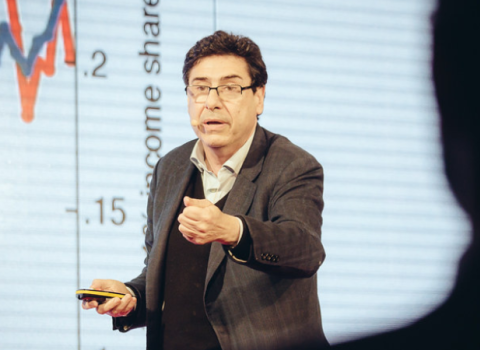The thousands of researchers around the world working on blood stem cells (haematopoietic stem cells) are hampered by the fact that these cells are in very short supply. Now, a Portuguese start-up, StemCell2MAX, partially funded by the European Research Council (ERC), has come up with a proprietary technology for multiplying blood stem cells in the lab without them losing their ‘stemness’ and differentiating into other types of blood cell. The company is looking for partners to help with the development of clinical applications.
Last month, Maria Brandão de Vasconcelos, the CEO and co-founder was given three minutes to explain to a panel of 11 judges from eight countries why of 30 competing teams, her company is the most investible. StemCell2MAX walked away with the award.
Receiving the Horizon 2020 –Invest Horizon Global Investor Summit ‘Most Investible Company’ prize, Filipa Matos Baptista, Chief Marketing Officer and co-founder of StemCell2MAX said, coming on top of the existing scientific and research market recognition, “This prize demonstrate that investors also believe in the potential of our company and StemCell2MAX technology.”
A second prize, ‘company to watch’ went to FabliTec, another start-up built around an ERC-funded project. The TU Munich spin-off is a specialist in 3D scanning technology.
The Winter University
The awards were made at the First Global Summit on Venture Finance and Innovation in Science, Space, Technology and the Creative Industries, held in Copenhagen last month. Here, nine ERC proof of concept grant winners joined approximately 30 start-ups from the European Space Agency and other organisations, for three days of entrepreneurship training and networking.
The three day summit, also known as the Winter University and organised in part by the European Business Angel Network (EBAN) started with a first day dedicated to intensive coaching of participating entrepreneurs, followed by the pitching competition.
The summit brought together more than 250 investors and 500 entrepreneurs in the Royal Academy of the Arts and Design in Copenhagen.
The ERC at the 2015 Winter University
ERC representatives taking part in the event were Klaus Bock, member of the ERC Scientific Council, Sierd Cloetingh, Vice-President of the ERC Scientific Council and Jens Rostrup-Nielsen, former ERC member. They joined the nine ERC proof of concept winners for the final two days, to share their knowledge and experience on the difficulties of commercialising scientific research.
The other ventures supported by proof of concept grants attending the Winter University were BrainGene from Lund University; PARQUEY from ETH Zurich; Theralight from ICREA in Barcelona, Optics 11 from University Amsterdam; BlueSense Diagnostics from the Technical University of Denmark; Silversky 3D from the University of Cyprus; LUMICKS from Amsterdam University; and Scan to Print from University College Dublin.
From lab to market
Since the ERC was established in 2007 with a brief to support excellent basic research, ERC grantees have had a number of notable successes. In 2014 Artur Avila and Martin Hairer were awarded the Fields Medal, the most prestigious mathematics prize in the world. The same year, Jean Tirole, who was awarded ERC funding in 2009, won the Nobel Prize in Economic Sciences for his analysis of market power and regulation.
Also in 2014, the Nobel Prize in Physiology/Medicine was awarded to the husband and wife team Edvard and May-Britt Moser, who between them have been awarded three ERC grants, with the first one going back to 2008.Another ERC-funded Nobellist is Konstantin Novoselov, who discovered graphene in 2007, work for which he won the Nobel Prize in physics in 2010, with his colleague Andre Geim.
Graphene is a basic science discovery, but the wonder material – it is weight for weight 100 times stronger than steel and a good conductor of heat and light - has many potential uses. Novoselov and Geim’s studies provided the inspiration for the EU’s €1 billion Graphene Flagship research project, which was launched in 2013 to develop applications for graphene. The project currently involves 142 academic and industrial groups in 23 countries.
Similarly, the science underpinning StemCell2MAX involved building an understanding the intricacies of the signalling molecules that prompt blood stem cells to make daughter cells. This was then translated into a reproducible, proprietary technology that is now available as a commercial product.
There are many other potential commercial gems to be found in the basic research done by ERC grantees.
Proof of Concept
To give researchers the opportunity to explore potential applications and bridge the gap between a piece of academic research and the first stages of commercialisation, the ERC created the proof of concept grant. The 18-month €150,000 grant supports technical validation, market research, clarifying the intellectual property strategy and investigating business opportunities.
There are currently around 300 proof of concept grants running. These cover a very broad range of activities including gene therapy for Parkinson’s disease; graphics and 3D visualisations; portable blood testing technology; and technology for finding parking spaces in cities.
While all the proof of concept grant holders have extensive experience in the lab, not all have business experience, as Rostrup-Nielsen noted. Given this, the international business angels gathered at the Winter University provided the right mixture of mentoring and coaching for projects that are not yet shaped up for venture capital investment.
In acknowledgement of ERC’s attempts to promote the translation of the basic research it funds towards market, EBAN presented its first-ever prize for ‘Innovation in Science Venture Finance’ to the ERC.




 A unique international forum for public research organisations and companies to connect their external engagement with strategic interests around their R&D system.
A unique international forum for public research organisations and companies to connect their external engagement with strategic interests around their R&D system.